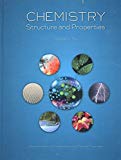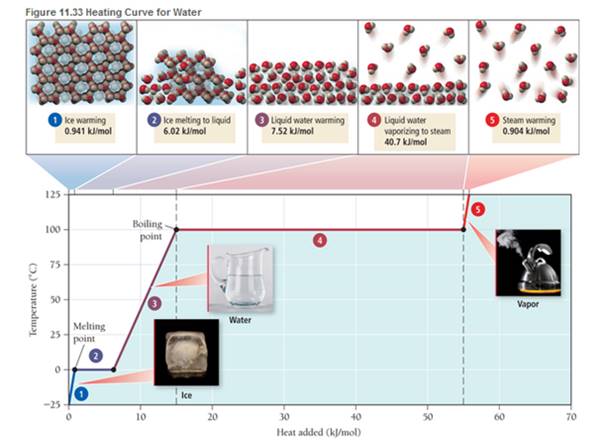
Chemistry: Structure and Properties Custom Edition for Rutgers University General Chemistry
15th Edition
ISBN: 9781269935678
Author: Nivaldo J. Tro
Publisher: Pearson Education
expand_more
expand_more
format_list_bulleted
Textbook Question
Chapter 12, Problem 88E
Draw a heating curve (such as the one in Figure 11.33) for 1 mol of benzene beginning at 00C and ending at 1000C. Assume that the values given here are constant over the relevant temperature ranges.
| Melting point | 5.4 0C |
| Boiling point | 90.10C |
| ΔHfus | 9.9 kJ/mol |
| ΔHvap | 30.7 kJ/mol |
| Cs, solid | 118 J/mol•K |
| Cs, liquid | 135 J/mol•K |
| Cs, gas | 104 J/mol•K |

Expert Solution & Answer
Want to see the full answer?
Check out a sample textbook solution
Students have asked these similar questions
Topic: Photochemistry and Photophysics of Supramolecules
Two cations that exchange an electron in an interface, the exchange density is worth 1.39 mA/cm2 and the current density is worth 15 mA/cm2 at 25°C. If the overvoltage is 0.14 V, calculate the reaction rate and symmetry factor. Data: R = 8,314 J mol-1 k-1: F = 96500 C
With the help of the Tafel line, it is estimated that the interchange density of the VO2+/VO2+ system on the carbon paper has a value of 3 mA cm-2. Calculate a) the current density if the voltage has a value of 1.6 mV and the temperature is 25°C. b) the beta value of the anódico process if the Tafel pendulum is 0.6 V at 25°C. Data: R = 8.314 JK-1mol-1, y F = 96485 C mol-1.
Chapter 12 Solutions
Chemistry: Structure and Properties Custom Edition for Rutgers University General Chemistry
Ch. 12 - Prob. 1SAQCh. 12 - Liquid nitrogen boils at 77 K. This image depicts...Ch. 12 - Taking intermolecular forces into account, which...Ch. 12 - What substance experiences dipole-dipole forces?...Ch. 12 - Prob. 5SAQCh. 12 - Prob. 6SAQCh. 12 - Determine the amount of heat (in kJ) required to...Ch. 12 - Prob. 8SAQCh. 12 - Prob. 9SAQCh. 12 - Prob. 10SAQ
Ch. 12 - Prob. 11SAQCh. 12 - Why do ethanol and dimethyl ether have such...Ch. 12 - Why are intermolecular forces important?Ch. 12 - Prob. 3ECh. 12 - Prob. 4ECh. 12 - Prob. 5ECh. 12 - Which factors cause transitions between the solid...Ch. 12 - Describe the relationship between the state of a...Ch. 12 - Prob. 8ECh. 12 - Prob. 9ECh. 12 - Prob. 10ECh. 12 - Prob. 11ECh. 12 - Prob. 12ECh. 12 - Prob. 13ECh. 12 - What is the ion-dipole force? Why is it important?Ch. 12 - Prob. 15ECh. 12 - Prob. 16ECh. 12 - What is capillary action? How does it depend on...Ch. 12 - Explain what happens during the processes of...Ch. 12 - Why is vaporization endothermic? Why is...Ch. 12 - Prob. 20ECh. 12 - What is the heat of vaporization for a liquid, and...Ch. 12 - Explain the process of dynamic equilibrium. How is...Ch. 12 - What happens to a system in dynamic equilibrium...Ch. 12 - Prob. 24ECh. 12 - Prob. 25ECh. 12 - Prob. 26ECh. 12 - Prob. 27ECh. 12 - Prob. 28ECh. 12 - Prob. 29ECh. 12 - Prob. 30ECh. 12 - Prob. 31ECh. 12 - Examine the heating curve for water in section...Ch. 12 - What is a phase diagram? What is the significance...Ch. 12 - Draw a generic phase diagram and label its...Ch. 12 - Prob. 35ECh. 12 - Determine the kinds of intermolecular forces that...Ch. 12 - Determine the kinds of intermolecular forces that...Ch. 12 - Prob. 38ECh. 12 - Arrange these compounds in order of increasing...Ch. 12 - Prob. 40ECh. 12 - Pick the compound with the highest boiling point...Ch. 12 - Pick the compound with the highest boiling point...Ch. 12 - Prob. 43ECh. 12 - Prob. 44ECh. 12 - Prob. 45ECh. 12 - Prob. 46ECh. 12 - Prob. 47ECh. 12 - Water (a) “wets” some surfaces and beads up on...Ch. 12 - The structures of two isomers of heptanes are...Ch. 12 - Prob. 50ECh. 12 - Water in a glass tube that contains grease or oil...Ch. 12 - When a thin glass tube is put into water, the...Ch. 12 - Which evaporates more quickly: 55 mL of water in a...Ch. 12 - Prob. 54ECh. 12 - Spilling room temperature water over your skin on...Ch. 12 - Prob. 56ECh. 12 - The human body obtains 915 kJ of energy from a...Ch. 12 - Prob. 58ECh. 12 - Suppose that 0.95 g of water condenses on a 75.0 g...Ch. 12 - Prob. 60ECh. 12 - Prob. 61ECh. 12 - Prob. 62ECh. 12 - Prob. 63ECh. 12 - Prob. 64ECh. 12 - How much energy is released when 65.8 g of water...Ch. 12 - Prob. 66ECh. 12 - An 8.5 g ice cube is placed into 255 g of water....Ch. 12 - Prob. 68ECh. 12 - Prob. 69ECh. 12 - Prob. 70ECh. 12 - Prob. 71ECh. 12 - Prob. 72ECh. 12 - Prob. 73ECh. 12 - Prob. 74ECh. 12 - Prob. 75ECh. 12 - The high-pressure phase diagram of ice is shown...Ch. 12 - Prob. 77ECh. 12 - Prob. 78ECh. 12 - Prob. 79ECh. 12 - How is the density of solid water compared to that...Ch. 12 - Prob. 81ECh. 12 - Prob. 82ECh. 12 - Prob. 83ECh. 12 - Prob. 84ECh. 12 - Four ice cubes at exactly 00C with a total mass of...Ch. 12 - Prob. 86ECh. 12 - Draw a heating curve (such as the one in Figure...Ch. 12 - Draw a heating curve (such as the one in Figure...Ch. 12 - Prob. 89ECh. 12 - A sealed flask contains 0.55 g of water at 280C....Ch. 12 - Prob. 91ECh. 12 - Prob. 92ECh. 12 - Prob. 93ECh. 12 - Given that the heat of fusion of water is —6.02...Ch. 12 - The heat of combustion of CH4 is 890.4 kJ/mol, and...Ch. 12 - Prob. 96ECh. 12 - Prob. 97E
Knowledge Booster
Learn more about
Need a deep-dive on the concept behind this application? Look no further. Learn more about this topic, chemistry and related others by exploring similar questions and additional content below.Similar questions
- Hi can you please help me solve this problem? thank youarrow_forwardAn electrode process takes place at a metal-solution interface. Indicate the current condition that must be met for Faradaic rectification to occur.arrow_forwardAt a metal-solution interface, an electron is exchanged, and the symmetry factor beta < 0.5 is found in the Butler-Volmer equation. What does this indicate?arrow_forward
arrow_back_ios
SEE MORE QUESTIONS
arrow_forward_ios
Recommended textbooks for you
 Chemistry: The Molecular ScienceChemistryISBN:9781285199047Author:John W. Moore, Conrad L. StanitskiPublisher:Cengage Learning
Chemistry: The Molecular ScienceChemistryISBN:9781285199047Author:John W. Moore, Conrad L. StanitskiPublisher:Cengage Learning Chemistry: An Atoms First ApproachChemistryISBN:9781305079243Author:Steven S. Zumdahl, Susan A. ZumdahlPublisher:Cengage Learning
Chemistry: An Atoms First ApproachChemistryISBN:9781305079243Author:Steven S. Zumdahl, Susan A. ZumdahlPublisher:Cengage Learning Principles of Modern ChemistryChemistryISBN:9781305079113Author:David W. Oxtoby, H. Pat Gillis, Laurie J. ButlerPublisher:Cengage Learning
Principles of Modern ChemistryChemistryISBN:9781305079113Author:David W. Oxtoby, H. Pat Gillis, Laurie J. ButlerPublisher:Cengage Learning General Chemistry - Standalone book (MindTap Cour...ChemistryISBN:9781305580343Author:Steven D. Gammon, Ebbing, Darrell Ebbing, Steven D., Darrell; Gammon, Darrell Ebbing; Steven D. Gammon, Darrell D.; Gammon, Ebbing; Steven D. Gammon; DarrellPublisher:Cengage Learning
General Chemistry - Standalone book (MindTap Cour...ChemistryISBN:9781305580343Author:Steven D. Gammon, Ebbing, Darrell Ebbing, Steven D., Darrell; Gammon, Darrell Ebbing; Steven D. Gammon, Darrell D.; Gammon, Ebbing; Steven D. Gammon; DarrellPublisher:Cengage Learning Chemistry: Principles and PracticeChemistryISBN:9780534420123Author:Daniel L. Reger, Scott R. Goode, David W. Ball, Edward MercerPublisher:Cengage Learning
Chemistry: Principles and PracticeChemistryISBN:9780534420123Author:Daniel L. Reger, Scott R. Goode, David W. Ball, Edward MercerPublisher:Cengage Learning ChemistryChemistryISBN:9781305957404Author:Steven S. Zumdahl, Susan A. Zumdahl, Donald J. DeCostePublisher:Cengage Learning
ChemistryChemistryISBN:9781305957404Author:Steven S. Zumdahl, Susan A. Zumdahl, Donald J. DeCostePublisher:Cengage Learning

Chemistry: The Molecular Science
Chemistry
ISBN:9781285199047
Author:John W. Moore, Conrad L. Stanitski
Publisher:Cengage Learning

Chemistry: An Atoms First Approach
Chemistry
ISBN:9781305079243
Author:Steven S. Zumdahl, Susan A. Zumdahl
Publisher:Cengage Learning

Principles of Modern Chemistry
Chemistry
ISBN:9781305079113
Author:David W. Oxtoby, H. Pat Gillis, Laurie J. Butler
Publisher:Cengage Learning

General Chemistry - Standalone book (MindTap Cour...
Chemistry
ISBN:9781305580343
Author:Steven D. Gammon, Ebbing, Darrell Ebbing, Steven D., Darrell; Gammon, Darrell Ebbing; Steven D. Gammon, Darrell D.; Gammon, Ebbing; Steven D. Gammon; Darrell
Publisher:Cengage Learning

Chemistry: Principles and Practice
Chemistry
ISBN:9780534420123
Author:Daniel L. Reger, Scott R. Goode, David W. Ball, Edward Mercer
Publisher:Cengage Learning

Chemistry
Chemistry
ISBN:9781305957404
Author:Steven S. Zumdahl, Susan A. Zumdahl, Donald J. DeCoste
Publisher:Cengage Learning
Chemical Equilibria and Reaction Quotients; Author: Professor Dave Explains;https://www.youtube.com/watch?v=1GiZzCzmO5Q;License: Standard YouTube License, CC-BY